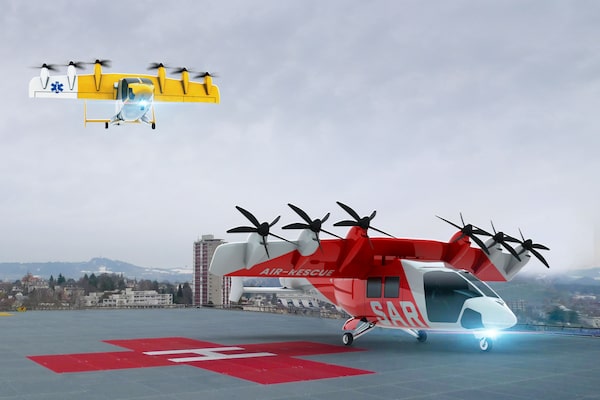
Handout rendering of the Dufour Aerospace Aero3, designed to respond to the requirements of both today’s helicopter operations and tomorrow’s advanced air mobility markets.Handout
Swiss aviation company Dufour Aerospace is establishing a Canadian base, hiring 30 software engineers in Montreal to build the platforms for gas-electric tilt-wing aircraft.
Dufour, which is developing hybrid aircraft for the air ambulance and medical-supply markets in Europe and North America, chose Montreal because it is home to a strong aerospace sector, well-regarded universities and a community of software developers, said Thomas Pfammatter, Dufour’s chief executive officer.
Dufour has developed two aircraft – one pilotless – that are inspired by the defunct Canadair CL-84 Dynavert, a once-innovative plane designed in the 1950s and 1960s with wings that tilted to allow vertical takeoffs and landings (VTOL). The design has regained favour for its ability to land in congested urban areas and atop buildings, as well as its efficiency.
Dufour’s Aero2, expected to begin production in 2024, is pilotless and built to deliver human organs for transplant or ferry food and equipment to remote areas. Prototypes are being flown in Switzerland.
The four-engine Aero3 is piloted, and has seating capacity for eight. Both planes are powered by gas and electricity, allowing them to fly farther than battery-only aircraft.
The Montreal region is the third-largest aerospace centre in the world, after Toulouse and Seattle, with 60,000 workers and several large manufacturers, including Airbus and Bombardier, according to industry group Aero Montreal. This “niche” makes it the ideal place to develop the systems that will run Dufour’s aircraft, said Jasmine Kent, Dufour’s chief technology officer.
In a webcast news conference on Tuesday, Ms. Kent said the Dufour aircraft are fully “fly-by-wire” and controlled by electronics, even the piloted version. “When you think of an airplane, you may think of the wings, the fuselage, the propulsion system, but one of the most critical features of a modern aircraft is the software,” Ms. Kent said. “And that software has to be designed to a higher standard than the software you’ll find in a computer.”
Several established operators of aircraft have made commitments to buy both planes, said Sascha Hardegger, Dufour’s chief commercial officer.
Dufour executives declined to say where final assembly of the planes will be, but Montreal is a possible location. Privately held Dufour’s first round of financing will last until the end of 2022, with another round expected shortly.
Canada is a large market for helicopters, which are far more expensive to operate than a hybrid aircraft, Mr. Pfammatter said.
About 15 early-stage companies are developing urban air mobility projects, including some that use a VTOL design. One such company, Dallas-based Jaunt Air Mobility, on Tuesday said former Air Canada chief Calin Rovinescu has taken a stake in the company. Jaunt is developing electric and hybrid VTOL aircraft at its manufacturing base in Montreal.
Mr. Pfammatter said he expects Dufour will benefit from government financing and tax credits, but it is too soon to provide details.
Dufour engineers based much of the aerodynamic design of the Aeros on the Canadair CL-84, studying flight data and NASA research on the aerodynamic attributes of the model, which was scrapped in 1974.
The U.S. military, the main potential purchaser of the plane, walked away after changing tactics in the Vietnam war.
Four CL-84s were made, and two crashed. One is on display in the Canada Aviation and Space Museum in Ottawa.
Your time is valuable. Have the Top Business Headlines newsletter conveniently delivered to your inbox in the morning or evening. Sign up today.
 Eric Atkins
Eric Atkins